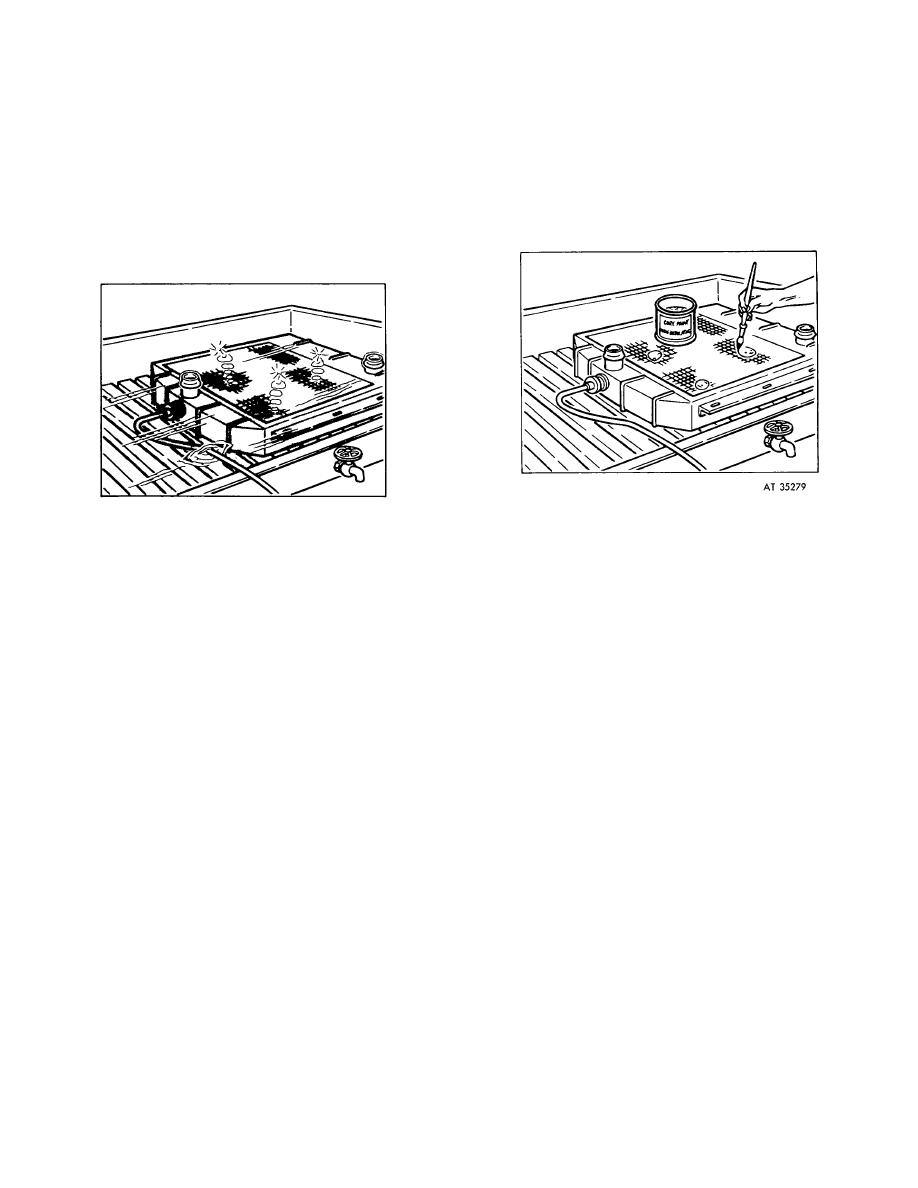 |
|||
|
|
|||
|
Page Title:
Figure 3-8. Leak testing a radiator. |
|
||
| ||||||||||
|
|
 f.
With test air pressure applied, lower radiator
eyedropper, oil can, acid brush, or swab. Compressed air
seeping through the leak will cause the liquid to foam
slowly into test tank while observing for air bubbles.
j.
g. Mark the source of the leak with scribe or other
The number of leaks and their location and the
general condition of the radiator will determine the
satisfactory means.
h. Some leaks are difficult to locate because of
advisability of repairing.
k. The leak test is conducted many times during
bubble deflections by the core fins. Lowering and raising
most repairs and requires raising and lowering the radiator
slowly or reducing air pressure will have advantages for
each time.
locating some difficult leaks.
I.
I.
In some cases a new core may be recommended
To find very small leaks, place the bench light in
when there are a large number of leaks or the core shows
back of the radiator so that the interior of the core can be
seen. Stand the radiator on the bench, and spread the
supposed leak with flux or soapy water from an.
Figure 3-8. Leak testing a radiator.
caused from leaky cylinder head gaskets, cracked cylinder
3-20.
Water Test
walls and cracks in the valve cooling passages.
Combustion leaks while the engine is operating will cause
a. General The water test, so called because leaks
oil and combustion gases to contaminate the cooling
are indicated by escaping water, replaces the air test when
system. Combustion leaks while the engine is stopped
equipment is limited or supplements it when the air test is
may cause the coolant to leak into the cylinders and the
suspected of being inadequate. Sediment and lime
lubricating oil sump. There are many methods that can be
deposited about leaky joints may be forced into the joints
used for locating combustion leaks.
by air pressure when the radiator is air tested, sealing the
b. Testing with Manual Transmission. This test
leak Leaks at the joint of tubes and header plates often
requires that a discarded spark plug be adapted for an air
refuse to show up under air pressure.
hose connection. To adapt the spark plug, remove the
porcelain element from the spark plug and braze a metal
b.
Test Procedure
air valve to the top of the plug. For this test the following
(1) Dry radiator after repairing leaks found by
procedure may be used.
air pressure, and test by water method.
(1) Drain coolant to thermostat level and
(2) Remove plug from filler neck and fill radiator
remove thermostat.
with water, being careful not to run It over or spill on the
(2) Fill thermostat housing to top with water.
outside.
(3) Remove all spark plugs and install adapter
(3) Examine core carefully for leaks.
in a spark plug hole.
(4) Place air hose over lower end of overflow
(4) Lock engine in gear with valves closed.
tube and hold palm of hand over filler neck, while a 5-
(5) Apply 125 psi air pressure to the air
pound pressure passes in against the water.
connection on the adapter and observe coolant level in
thermostat housing.
3-21.
Combustion Leak Test
a.
General.
Engine combustion leaks may be
3-8
|
|
Privacy Statement - Press Release - Copyright Information. - Contact Us |